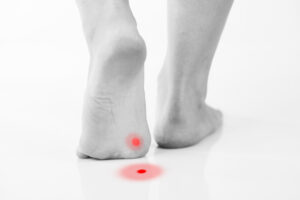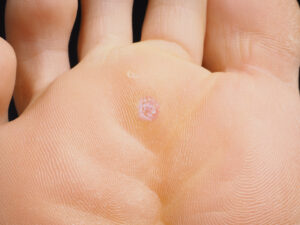How to Treat a Verruca

What is a Verruca?
A Verruca is a small viral skin lesion or (plantar wart) found on the bottom of the foot or toes, which closely resembles, and is often confused with a corn. Its size is usually under 1cm in diameter but can grow larger and can also occur in clusters (mosaic warts).
Children are the most susceptible to Verrucae infection, as at this age, the immune system is not fully developed. Verrucae are also easily spread from person to person in places such as showers, around swimming pools, in gyms, locker rooms, saunas and rough wet surfaces where skin and infected particles are easily removed.
What causes Verrucae?
Verruca Pedi are caused by the human papilloma virus. This is a slow growing virus found in most of our environments, and gains entry into the body through a break in the skin, such as a scratch or cut. The virus only grows in the epidermis, the thick layer of skin closest to the surface. Verrucae don’t invade the dermis, (the deeper layer of skin), just the epidermis. The Verruca grows extra blood vessels and nerves in response to the virus. It is because of these nerves, that the verruca hurts when pinched and because of these blood vessels that it stays well nourished and grows.
The virus particles can spread from the main verruca, along the cutaneous (skin) nerves, to begin growing remote or satellite verrucae at a distance from the original site. If enough of this spread occurs, mosaic verrucae result. Verrucae are more common in children as their immune system is not fully developed. Part of the treatment for a verruca often involves stimulating the body's immunity to stimulate a healing response.

How do I know if I have a Verruca?
A verruca feels like a small lump under the foot. It can be painful if you squeeze or pinch it or bear direct weight on it. Unless the verruca occurs on weightbearing surfaces, it will protrude above the level of the skin showing a rough ‘cauliflower’ surface. Verrucae found on weight bearing areas are forced to grow inwards and as a result can be painful as they press on the skins nerves. These Verrucae often have a layer of callous on their surface, giving them a yellow/grey shiny appearance.
Reduce the pain from a verruca
Ultimately the goal of treatment is the removal of the painful lesion. Often, the verruca will become more painful the larger it gets, and the deeper it sits in the skin of the foot. Temporary pain relief can sometimes be had by removing the bulk of the tissue, but this means that the problem still remains, and the pain is likely to quickly return. That is why pain reduction is primarily focused on permanently removing the viral tissue and the painful verruca.
Verruca treatment
On visiting your podiatrist, a diagnosis can often be based on characteristic appearance alone. Firstly, your podiatrist trims any hard skin (callous), which will reveal the small blood vessels that feed the verruca. They look like small black dots. Your podiatrist will also test the verruca by pressing directly down on it and then pinching it from side to side. Your podiatrist has a number of choices for treating verrucae pedis. We will start with acid treatments that are stronger than what is available at the pharmacy to help speed up the process. Nitric Acid has the benefit of not diluting when wet. Acids work by breaking the verruca capsule, allowing the body’s immunity to take over and reducing the bulk of the viral material. Liquid nitrogen (cryosurgery) freezes the skin to induce a blister that will rupture the Verruca and shed the infected particles.
The problem with this treatment is that it can be painful and may leave viral particles behind, causing regrowth. Depending on the size and number of verrucae, these treatments can take from one to several treatments before the verruca is completely removed.
Long term verruca solution
As with most conditions getting the correct diagnosis in the first place is very important. Verrucae can be often misdiagnosed and wrongly treated. They can be diagnosed as corns or cysts, which look very similar to verrucae, although the treatments are quite different. Treatment involves anaesthetic to numb the area and the use of an instrument called a curette to remove the verruca whole. The healing time is 2-4 weeks, depending on its size.
Conservative (non-surgical) treatments are the first line of treatment for verrucae. These usually involve topical applications, such as acids and other caustic agents, to try and help remove and kill the viral tissue. One of the problems with these is that the verruca may be deep into the skin, and so this treatment can be painful. Once your podiatrist has completed an initial assessment, they will be able to determine the best course of action, with the aim to completely remove the rerruca and reduce the possibility of recurrence. If non-surgical treatment isn't an option, surgery may be the route to remove the verruca in one visit completely. Many verrucae are stubborn and even the best methods for removing them allow a rate of reoccurrence of around 15%.
Still in Pain?
Are you are feeling like you have tried everything but are still in pain?
Do you feel like you have seen every health practitioner you can about your verruca pain?
We have a track record of diagnosing and successfully treating cases that have previously proven difficult to resolve and we'd love to help you get back on your feet doing what you love.


Thanks
My sore is on the top of the first joint of my big toe lt won’t heal even after 9 weeks william omalley